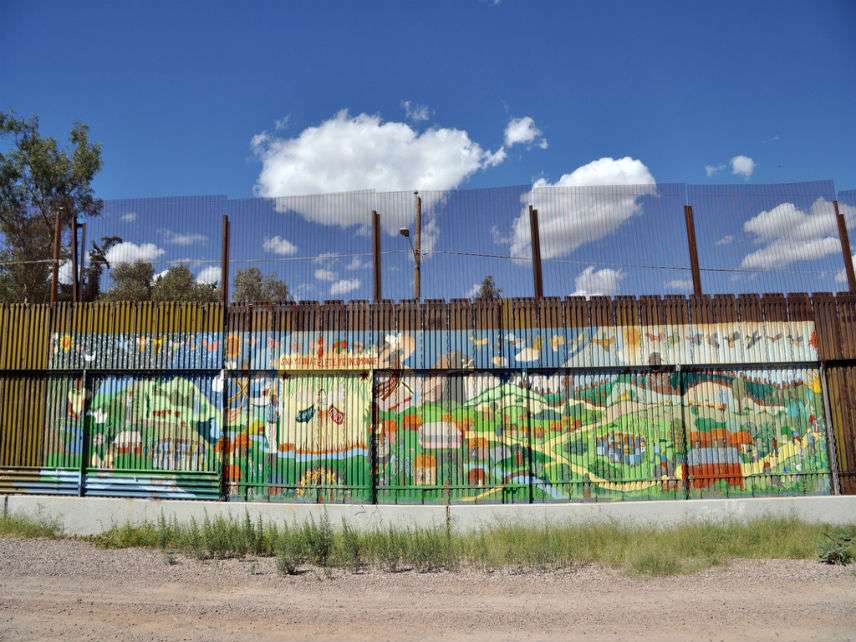The Great Wall of Trump Is Fighting the Last War
More Mexicans are leaving than coming to America.
Mexico was never going to pay for Donald Trump's 2,000-mile construction project—aka wall—along the Rio Grande. So he has taken

Dreamers hostage to try and extract $20 billion from American taxpayers. (Dreamers are folks who were brought to this country as minors illegally but have grown up as Americans whose temporary protected status Trump will phase out in March, when they will be up for deportation unless Congress acts.)
It's unclear if he'll succeed in securing funding for this monstrosity given that after initially caving, Democrats retracted their offer after it failed to produce much reciprocity from the administration, only an escalation of restrictionist demands.
But erecting a giant barrier between two friendly nations would be profoundly sad; even mortal enemies like India and Pakistan don't have such structures between them. And it would be tantamount to fighting the last war, given that illegal immigrant flows from Mexico have dropped sharply, and aren't likely to go back up.
Net migration flows between America and Mexico dropped to zero in the recession's immediate aftermath, because as many Mexicans left the country as entered. But since then, these flows have reversed from their recent historic norms, with more Mexicans now leaving the United States than coming in.
During the peak years of Mexican migration, between 1995 and 2000, about 3 million Mexicans came to the United States. That number was slashed in half in the five years that followed, and then another half — or 870,000 — between 2009 and 2014. At the same time, 1.4 million Mexicans returned home.
The upshot is that America's unauthorized Mexican population — the big restrictionist boogeyman — shrank from 6.9 million in 2007 to 5.6 million in 2014. Border hawks like to take credit for this shrinkage, attributing it to stepped-up enforcement at the border and deportations from the interior. But that's just not the case.
The number of border apprehensions in any given year is a fair proxy for how many people are trying to jump across. But even as President Barack Obama was busy doubling the number of border patrol agents, the overall apprehension rate continued to fall. Indeed, in the mid-1980s, when flows were high, each agent caught 400 people per year. In 2016, each agent nabbed fewer than 17, Cato Institute's David Bier estimated.
It is true that deportations shot up on President Obama's watch. But of the 1 million Mexicans who returned between 2009 and 2014, only 14 percent were due to deportations. The rest returned voluntarily, the vast majority (61 percent) to be reunited with their family and friends.
None of this ought to come as a huge surprise. The couple of decades of high immigration from Mexico that America experienced were the result of a unique convergence of events. Mexico was undergoing a "demographic transition" — meaning that its infant mortality rates had fallen, thanks to advances in modern medicine, but its fertility rates hadn't because parents hadn't quite absorbed the fact that their children were more likely to survive, leading to a population explosion. Every modernizing country has gone through this phase. Meanwhile, the Mexican economy of the 1980s was in a freefall after a decade of government profligacy, and the American economy was taking off. Is it any wonder that America became a magnet for young Mexican men searching for jobs to feed their fast-growing families?
But this is no longer our reality. Mexico's birth rates have plummeted from 7.3 children per woman in the 1960s to 2.4 per woman now. That's just above replacement level. Mexico's economy, thanks to NAFTA (which Trump is hell-bent on destroying), has been growing at a nice clip, creating jobs at home. Mexico simply doesn't have the labor surplus anymore to send America's way.
All of this is borne out by Mexico's emigration data. In 2006, 144 out of every 10,000 Mexicans were leaving the country for better climes. In 2015, that number had dropped to 39 per 10,000.
This is nothing to celebrate. America's economy over the last several decades has been built on the backs of Hispanic migrants willing to work their tails off in jobs that Americans simply don't want to do. In a rational world, the president wouldn't be wasting taxpayer dollars on militarizing the southern border to repel peaceful workers from a friendly neighbor. He would be sending them invitation cards to come north and help him Make America Great Again.
A version of this column originally appeared in The Week




Show Comments (285)